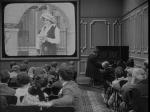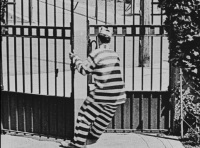
 I only recently became aware of the Selig Polyscope Studio, the first permanent studio built in Los Angeles that opened in 1909 two blocks north from where the Keystone Studio would later open. Focusing on the facility’s distinctive walls and turrets, I realized Charlie Chaplin filmed early scenes here beside the studio, as detailed in this recent Charlie at Selig post, including the movie-within-a-movie scene Charlie and Mabel Normand watch during Tillie’s Punctured Romance (1914) featuring the Selig Studio’s corner gated entrance (above right).
I only recently became aware of the Selig Polyscope Studio, the first permanent studio built in Los Angeles that opened in 1909 two blocks north from where the Keystone Studio would later open. Focusing on the facility’s distinctive walls and turrets, I realized Charlie Chaplin filmed early scenes here beside the studio, as detailed in this recent Charlie at Selig post, including the movie-within-a-movie scene Charlie and Mabel Normand watch during Tillie’s Punctured Romance (1914) featuring the Selig Studio’s corner gated entrance (above right).
Once this “new” Selig locale found its place in the mosaic of silent movie geography, the transitive theory of film locations kicked in. The Selig photos confirmed Chaplin filmed here, and in turn the Chaplin movie clues confirmed the next discovery – Buster Keaton filmed his prison gate scene from Convict 13 (1920) at the Selig Studio corner as well.
As I explain in my book Silent Echoes, Keaton filmed his prison comedy Convict 13 primarily at a large outdoor prison set on the backlot Romaine/Cahuenga corner of his small studio (notice the two guard towers, one on the ground, in this 1921 aerial view HollywoodPhotographs.com). When Buster stands on the prison gallows, you can see various Metro Studio buildings further south along Cahuenga behind him.

A “real” non-prison gate standing in for a prison – Hank Mann in The Janitor (1919); Charlie Chaplin in Police (1916); Stan Laurel in Detained (1924). See Four Jails post.
 Despite Buster’s elaborate studio set, I long suspected the corner gate appearing in Convict 13 was actually “real.” First, I knew genuine gates portrayed prison gates in other silent comedies (for example above, the frequently used Los Angeles County Psychopathic Hospital gate explained in my Four Jails post). Keaton’s gate seemed both too detailed, and yet not sufficiently intimidating, to be a set built to look like a prison. I also knew the gate was not filmed at Keaton’s studio, as the steep uphill street at back doesn’t match the flat studio site. So once I became aware of the Selig gate, the pieces fell into place.
Despite Buster’s elaborate studio set, I long suspected the corner gate appearing in Convict 13 was actually “real.” First, I knew genuine gates portrayed prison gates in other silent comedies (for example above, the frequently used Los Angeles County Psychopathic Hospital gate explained in my Four Jails post). Keaton’s gate seemed both too detailed, and yet not sufficiently intimidating, to be a set built to look like a prison. I also knew the gate was not filmed at Keaton’s studio, as the steep uphill street at back doesn’t match the flat studio site. So once I became aware of the Selig gate, the pieces fell into place.
Click to enlarge – the proportions and details all match. Keaton’s corner gate at Clifford St. and Glendale Blvd. stands within a curved arch, with staggered rectangular elements filling the curve, matching the Selig gate photo, Clifford St. sloping uphill across the street at back, and this close-up from Tillie’s Punctured Romance.
While addressed more fully in this post, I’ll briefly share that opening scenes from One Week (1920) and Convict 13 were filmed on Los Feliz, when it was still a open road. Click to enlarge – the two left images look west towards the public stairway where Los Feliz turns south – the two right images look east at the corner of Los Feliz and Serrano.
Also awaiting a future post, most Convict 13 golf scenes were filmed at the newly opened California Country Club near Culver City.
A final view of the Selig Studio, later home to Clara Kimball Young – Tommy Dangcil. Notice Buster’s “prison gate” to the left. Below, the corner of Clifford and Glendale, where the Selig Studio entrance gate once stood.
Please help support naming the Chaplin Keaton Lloyd alley by posting a review on Google Maps. Prototype sign design – Piet Schreuders. Download a brochure HERE.

















John, I feel stupid… I knew your name was familiar…I love your book Silent Echoes with Buster Keaton. I bought it in the early 2000s and have enjoyed it ever since. Thanks for that great book. I plan on getting the Chaplin and Lloyd next month.
LikeLiked by 1 person
Thank you so much. In all modesty I think my Lloyd book is the best. I had access to the most archival photos, Piet Schreuders prepared some wonderful 3d maps, and it was fun studying NYC as well as LA.
LikeLiked by 1 person
Good post.
My understanding is that the Selig Studio was also known as the Bison Studio; and that Sennett bought that as part of his Keystone studio?
LikeLike
rangerdon, Selig and Bison were two different facilities, located several short blocks from each other on the same street. Thomas Ince’s Bison opened in 1909, and Mack Sennett’s Keystone (a part of the same parent company) moved there in 1912. Sennett maintained that as his main studio through 1927. The Selig studio up the street briefly became a Fox facility after Selig moved to Lincoln Park, then a series of other names. What confused things is that in 1954, a plaque was placed to honor the former Sennett studio, but it was mistakenly put on the site of the Selig studio instead. That was rectified in recent years with the plaque put on the one surviving building of the former Keystone/Sennett studio. (Nothing remains of the Selig studio.)
LikeLiked by 1 person
I’m afraid to say I don’t know the Selig/Bison/Sennett connection. As mentioned, I only became aware of Selig just a few weeks ago, and my brain was busy figuring out the photo connections. Thanks so much, John
LikeLiked by 1 person
Thank You for the clarification between the Bison and Selig Studios. I thought that Bison was first. I saw the episode of California’s Gold with Huell Howser that was talking about the mistake. I live in old Edendale now Silver Lake. I’m on top of the east side of the lake a few blocks from the condos that replaced the original Selig, then Fox and the Clara Kimball Young Studio among others. I lived in Beachwood Canyon 80’s – 90’s before Silver Lake a couple of blocks away from Chaplin’s Temple Hill House. There is a tiny bungalow just north of the (Sennett) Public Storage on Glendale Blvd. It has a sign saying that it is the spot of Chaplin’s first filming in 1914. I was wondering if that bungalow was part of the Sennett complex back in the day? Living in B.C. started my endless fascination with the migration of stars and studios as they moved west. Hollywood before there was a Hollywood. I take relatives on driving tours of Old Hollywood so it’s always great to have more tidbits of history. I have family that still talk about walking up the Laurel & Hardy stairs from The Music Box. Take care
LikeLiked by 2 people
Hi Jolino – thank you for sharing. Do you have the particulars for this tiny bungalow? In a similar way, there was a front porch home next door to the studio, now the Jack in the Box driveway, where Chaplin and others filmed early scenes – https://silentlocations.com/2014/06/13/chaplins-first-scene-a-very-busy-place-to-film/ Take care, John
LikeLiked by 1 person
Fascinating research as usual. I wonder if the phantom film-makers sought permission to film outside the picturesque Selig Studio? Perhaps it was a case of ‘shoot and run’! BTW the Keystone studio next door was originally the Bison Studio. That’s right, they made cowboy films there! There may have been some connection between Bison and Selig, but I have never seen it mentioned anywhere. Thanks for the blogs (and the books).
LikeLiked by 1 person
Maybe it was shoot and run, but that seems a bit rude. Maybe they just popped their head in the front office to let them know, and started to shoot. Somebody on Keaton’s staff had to know about this gate as a possible location.
LikeLiked by 1 person
Yes. I’ve been researching movie studios and filming in early Los Angeles for a new book. The research indicates the Bison studio was the first one built in Southern California. There was a temporary studio for the filming of The Squaw Man, and movies were filmed there earlier, but Bison was the first one built, in what was then Edendale. It became the Keystone Studio. I’m fairly certain the Selig studio came a little later. Interestingly, most of the early studios were NOT in Hollywood, but the Los Feliz area and Edendale. Hollywood was a brand name developed by the European and east coast merchants who took over film from the pioneering artists like Griffith.
As to filming westerns in Edendale: In those early days, most of that area was rural. Ruthie Tompson, Disney Legend, remembers wandering as a child through wild flower-covered hills as she walked from her family home on Kingvale to visit her aunt and uncle on Waverley. Much of the nearby land would become Griffith Park. Even today, you can rent horses in Atwater Village, splash through the LA River, and saunter up into Griffith Park – where you might even see a mountain lion. So filming westerns in nearby Edendale made sense. (Mixville studio was also in that area.)
Thanks for provocative entry in this always-fascinating blog.
LikeLiked by 2 people
Wow, thank you for this information. That’s exciting you’re working on a book. I glanced through a recent book “Colonel Selig, The Man Who Invented Hollywood” by Andrew Erish. Have you seen it? Good luck with your project
LikeLiked by 1 person
Pingback: Harold Lloyd’s Earliest Days Filming in Edendale | Chaplin-Keaton-Lloyd film locations (and more)
Pingback: Charlie Chaplin’s Once Lost Film – A Thief Catcher | Chaplin-Keaton-Lloyd film locations (and more)